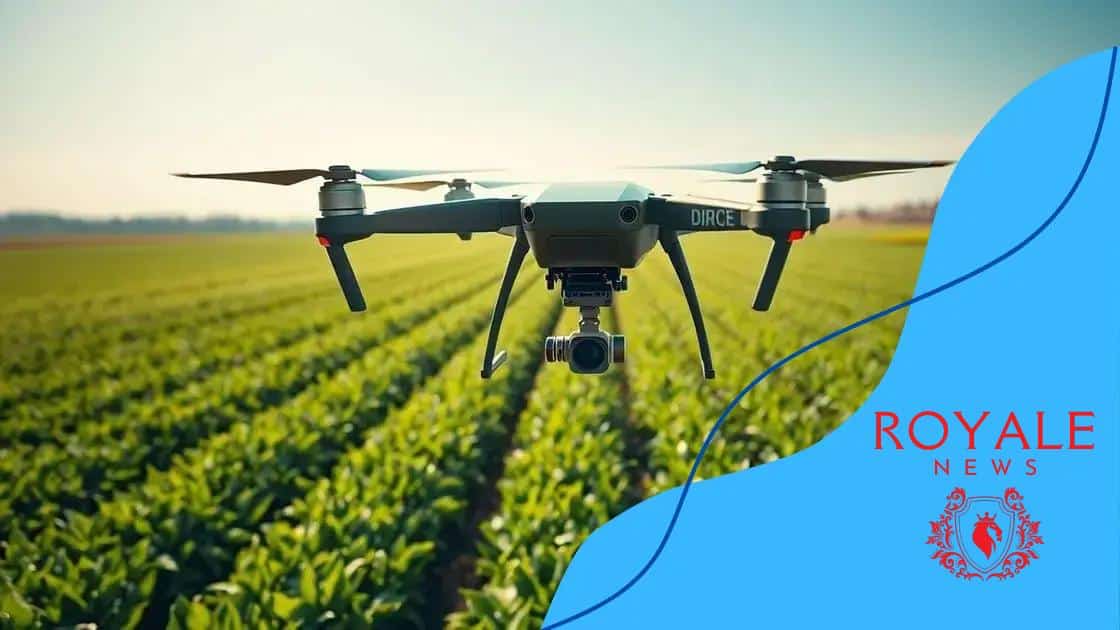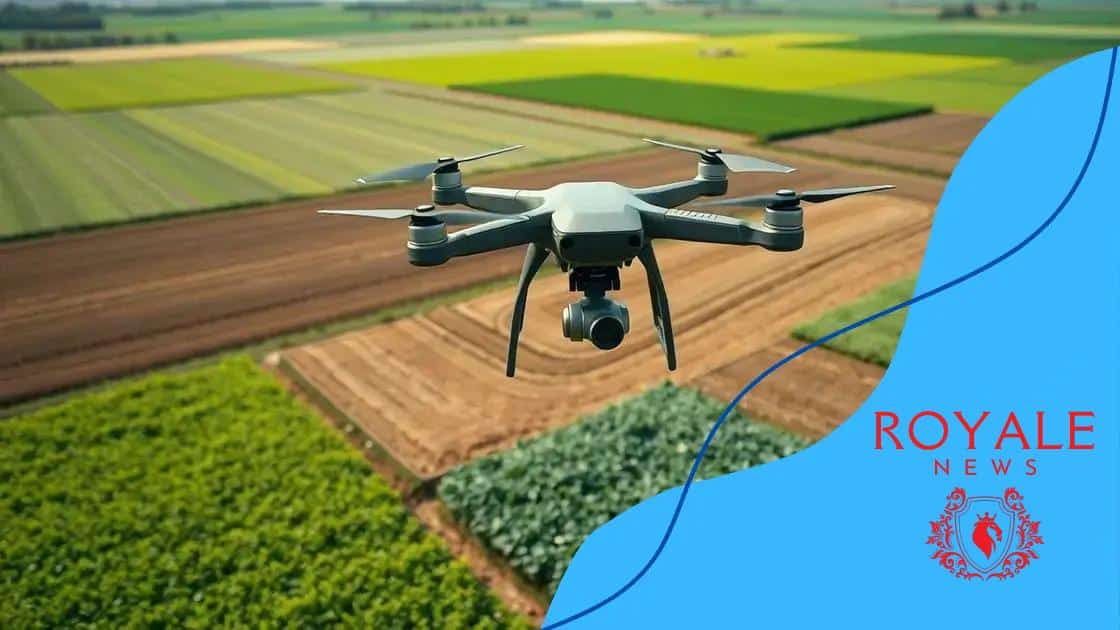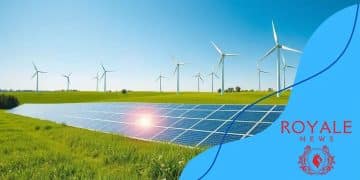Drones in agricultural optimization: a game changer

Drones in agricultural optimization enhance crop monitoring, reduce costs through targeted applications, and promote sustainable practices, thus revolutionizing modern farming techniques.
Drones in agricultural optimization are transforming how farmers approach their crops. Imagine having the ability to monitor your fields from above, receiving real-time data to enhance productivity and sustainability. Curious about how this technology can change your farming practices? Let’s dive in!
Understanding drones in agriculture
Understanding drones in agriculture is essential for modern farming. These devices are not just toys; they play a vital role in enhancing agricultural practices. By capturing high-resolution images and data from above, drones help farmers make informed decisions about their crops.
What Are Agricultural Drones?
Agricultural drones are specialized unmanned aerial vehicles (UAVs) designed for farming applications. They can monitor large areas of land quickly and efficiently. Equipped with advanced cameras, these drones can capture images that reveal the health of plants and the condition of the soil.
Benefits of Using Drones
Incorporating drones into farming practices can lead to several advantages:
- Improved crop monitoring: Drones can identify areas needing attention, ensuring that resources are allocated effectively.
- Time efficiency: Farmers can cover vast areas in a short time, allowing them to manage their time better.
- Cost savings: By pinpointing problem areas, farmers can reduce inputs and enhance yields, thereby increasing profitability.
As technology advances, the applications of drones in agriculture continue to expand. They help in assessing crop health, optimizing irrigation, and even aiding in pest management. This not only benefits farmers but also contributes to sustainable agricultural practices.
Understanding how drones work in agriculture, from their design to their capabilities, opens doors to a world where precision is key. With real-time data, farmers are better equipped to respond to the changing needs of their crops, making agriculture a more productive and sustainable endeavor.
The Future of Drones in Agriculture
Looking ahead, the integration of drones into farming is expected to grow. Enhancements in AI and data analytics will provide farmers with even more tools to optimize their operations. As regulations evolve and technology becomes more accessible, the potential for drones in agriculture is limitless.
Impact on crop monitoring and management
The impact on crop monitoring and management through the use of drones is profound. Drones offer a bird’s-eye view of fields, allowing farmers to identify issues that are not visible from the ground. This technology enables more effective decision-making and timely interventions.
Real-Time Data Collection
One of the primary benefits of drones is their ability to collect real-time data. Farmers can monitor crop health, assess soil conditions, and even track pest populations. This information is crucial for precise management practices, helping to optimize yields.
Enhanced Field Mapping
Drones can create detailed maps of fields, which are essential for managing crops effectively. These maps provide insights into:
- Soil variability: Different areas of a field may have varying soil types and nutrient levels.
- Water management: Drones can identify areas that require irrigation or drainage.
- Crop health: Visual data helps in spotting areas of stress or disease early.
With enhanced mapping, farmers can tailor their management practices to suit the specific needs of each field section. This not only boosts productivity but also enhances sustainability.
Moreover, drones can help reduce the amount of chemical inputs by identifying specific areas that need treatment. This targeted approach minimizes waste and lowers costs, making agriculture more efficient.
Improving Harvest Strategies
The insights gained from drone data can lead to better harvest strategies. Knowing when to harvest is critical, and drones can assist in determining the optimal timing by assessing crop maturity and quality. This can result in higher-quality yields and reduced waste.
Through these advancements in crop monitoring and management, drones are revolutionizing the way farmers approach their work. The integration of this technology supports the pursuit of more sustainable and productive agricultural practices.
Enhancing precision agriculture with drones

Enhancing precision agriculture with drones is transforming the way farmers approach their fields. By utilizing drones, farmers can obtain valuable insights that lead to better decision-making and improved crop management.
What is Precision Agriculture?
Precision agriculture involves using technology to monitor and manage crop variations within fields. Drones play a crucial role in this process, offering a unique perspective and delivering data that can optimize farming practices. With high-resolution images, farmers can assess plant health, moisture levels, and nutrient needs effectively.
Key Benefits of Drones in Precision Agriculture
The integration of drones into precision agriculture offers several advantages:
- Data accuracy: Drones provide accurate, real-time data through sophisticated sensors and cameras.
- Resource efficiency: With precise information, farmers can apply water, fertilizers, and pesticides more efficiently, saving costs and promoting sustainability.
- Yield increase: By identifying issues early, like disease or nutrient deficiencies, farmers can improve crop yields significantly.
Additionally, drones can perform tasks like mapping fields and analyzing soil health. This information is essential for making informed decisions and employing targeted interventions for crop care. Farmers can use the data collected to adjust their practices dynamically, ensuring that every part of the field gets what it needs.
Future of Drones in Precision Agriculture
The future of enhancing precision agriculture with drones looks promising. Innovations in drone technology will continue to expand capabilities, including better data analytics and automated systems. This means farmers can expect even greater insights and improved efficiency.
Incorporating drones into precision agriculture represents a major step toward sustainable farming. The efficiency and effectiveness that these tools offer can significantly change agricultural practices for the better. By leveraging drone technology, farmers are equipped to meet the challenges of a growing population and changing climate.
Cost-effectiveness of drone technology
The cost-effectiveness of drone technology in agriculture is a key reason why many farmers are adopting this innovative tool. Drones offer a variety of benefits that can lead to significant savings and increased productivity.
Initial Investment vs. Long-Term Savings
While purchasing a drone may involve a considerable initial investment, the long-term savings can be substantial. Farmers can save money through:
- Precision application: Drones allow for targeted application of fertilizers and pesticides, reducing waste and costs.
- Labor savings: Drones can perform tasks that would typically require a team of workers, decreasing labor costs.
- Time efficiency: Tasks that used to take hours can now be completed in a fraction of the time, allowing farmers to manage more land.
In addition to these savings, drones also help improve overall crop yields. By providing accurate data about plant health and soil conditions, farmers can make timely adjustments to their strategies. This can lead to maximized production and reduced crop losses.
Case Studies Showing Cost Benefits
Several case studies highlight the financial advantages of integrating drones in farming practices. For example, a study found that farmers using drones recorded up to a 15% increase in crop yields with a corresponding decrease in input costs. Another case demonstrated how a vineyard used drones for monitoring, ultimately reducing water usage significantly.
These success stories illustrate that while drones may be seen as a luxury, they are rapidly becoming a necessity for competitive farming operations. The data collected helps farmers make smarter decisions, leading to improved resource management and financial stability.
As more farmers realize the potential savings and benefits, drone technology is likely to continue expanding within the agricultural sector. The blend of technological advancement and cost-effectiveness positions drones as a valuable tool in modern farming.
Future trends in agricultural drone applications
The future trends in agricultural drone applications are bright and full of potential. As technology continues to advance, we can expect drones to become even more integrated into farming practices. This will lead to enhanced productivity and sustainability in agriculture.
Increased Automation
Automation is one of the most significant trends in the agricultural sector. Drones are evolving to perform more complex tasks, such as:
- Automated field mapping: Drones will create precise maps of fields, allowing farmers to plan and manage their resources more effectively.
- Autonomous crop spraying: Future drones may be capable of autonomously spraying crops, reducing labor costs and increasing efficiency.
- Real-time data analysis: Drones will likely incorporate advanced data analytics to provide farmers with instant insights about crop health and soil conditions.
These advancements will not only save time but also enhance the accuracy of agricultural practices.
Integration with AI and IoT
The integration of drones with artificial intelligence (AI) and the Internet of Things (IoT) will further revolutionize agriculture. By combining these technologies, farmers will gain:
- Enhanced decision-making: AI algorithms can analyze data collected by drones to suggest actionable insights.
- Improved resource management: IoT connectivity will allow drones to relay real-time information to farmers, optimizing water and fertilizer use.
- Better pest management: AI can help identify pest outbreaks more quickly, allowing for timely interventions.
This integration creates a more comprehensive framework for modern farming, allowing for better predictions and strategies.
Sustainability Focus
As the world shifts towards sustainable practices, agricultural drones will play a key role. Drones can help monitor the environmental impact of farming techniques, enabling farmers to:
- Minimize chemical usage: By targeting specific areas that need treatment, farmers can reduce pesticide and fertilizer application, promoting a healthier environment.
- Monitor water usage: Drones can assess irrigation effectiveness, helping to conserve water resources.
- Support biodiversity: With precise monitoring, farmers can ensure that their practices do not harm surrounding ecosystems.
These trends indicate that drones will become an even more important tool in helping farmers address global challenges.
In conclusion, the integration of drones in agriculture represents a significant shift in how farmers manage their operations. Drones enhance precision, improve efficiency, and promote sustainability. As technology advances, we can expect even more innovations that will improve crop monitoring, reduce costs, and support eco-friendly practices. Ultimately, embracing drone technology will enable farmers to meet the demands of a growing population and a changing environment, ushering in a new era of agricultural practices.
FAQ – Frequently Asked Questions about Drones in Agriculture
How do drones improve crop monitoring?
Drones provide real-time data and high-resolution images of fields, helping farmers assess crop health and identify issues early.
What are the cost benefits of using drones in farming?
Drones enable targeted applications of pesticides and fertilizers, reducing costs and minimizing waste, which leads to overall savings.
Can drones help with sustainable farming practices?
Yes, drones can reduce chemical usage and optimize resource management, making farming practices more sustainable.
What future trends can we expect with agricultural drones?
We can expect advancements in automation, integration with AI and IoT, and enhanced capabilities for more effective farming.





